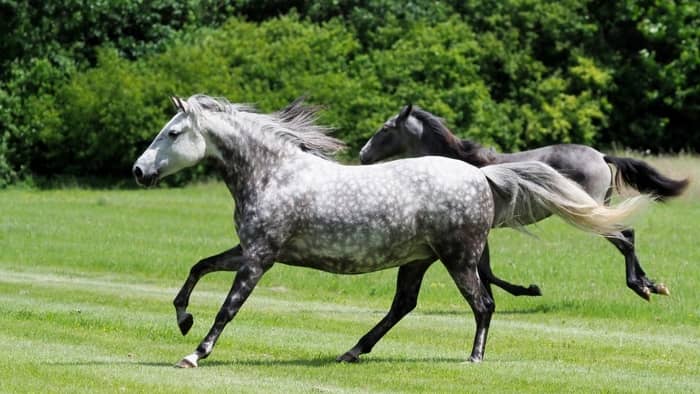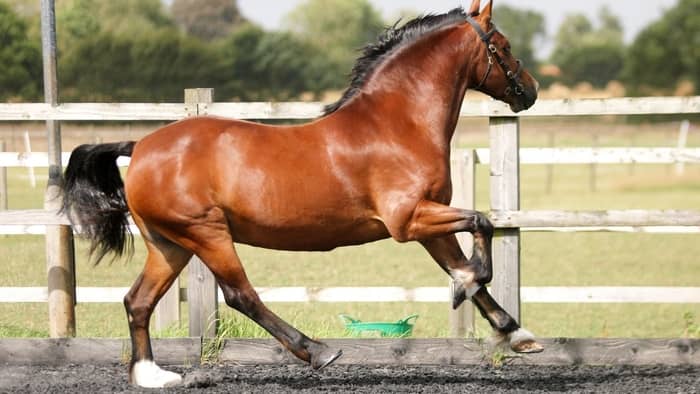Last Updated on January 9, 2022
We all know that horses can move at impressive speeds, and there is no more beautiful sight than a horse cantering along a hillside trail! However, the pace a horse travels at can affect how the distance it can travel. So, how long can a horse canter for?
Let’s find out all about the different speeds of a horse, and how they affect the distance they can travel. You will be amazed at just what distances a horse is capable of traveling!
What Are The Different Speeds Of A Horse?

Most horse breeds and types have four different paces – walk, trot, canter, and gallop. These paces, also known as gaits, all differ in the order that the horse moves its legs. The gaits of a horse are also different in terms of how fast they are, and the energy required to carry them out.
-
Walk
The walk is the slowest pace of the horse, at an average of 4.3 miles per hour. It is a four-beat gait, and the horse will always have two or three feet on the ground.
When walking, a horse will move a hind leg, then the foreleg on the same side. It then moves the opposite hind leg, followed by the opposite foreleg.
At the walk, the horse uses very low amounts of energy. However, this pace is very slow, and the horse cannot cover the ground quickly when walking.
-
Trot
Trotting is one of the most economical speeds for a horse in terms of speed in relation to energy used. This is a two-beat gait, with an average speed of 8.1 miles per hour. However, the speed of a trot can vary greatly, and racing trotters have been recorded at speeds of over 30 miles per hour.
At the trot, the horse moves its legs in diagonal pairs. It will move the left hind and right fore leg at the same time, and then move the right hind and left fore leg together.
This gait is comfortable for the horse and uses minimal energy levels. A fit and healthy horse can maintain a steady trotting pace for several hours.
-
Canter
The canter is a three-beat gait with average speeds of 10-17 miles per hour, depending on the type and height of the horse. The movement of the legs at a cantering pace is very complex, but you will be able to hear and count three beats, followed by a pause.
At a cantering pace, the horse is propelled forward by one of the hindlegs, while the other three legs are all moving forward in the air. The other hindleg and its opposite foreleg land on the ground first, followed by the remaining foreleg.
Cantering is not as easy as trotting for the horse and puts more pressure on the cardiovascular system and musculoskeletal systems. In the wild, a horse will normally canter for a short distance to remove himself from danger, and then proceed at a trot.
-
Gallop
The gallop is the fastest pace of a horse, averaging 25 to 30 miles per hour. At the gallop, the beat changes to a four-beat gait, and the limbs move so quickly it can be hard to identify the order in which they move. This is the pace that horses travel at during modern-day horse racing events.
A horse uses the galloping pace to move quickly away from danger. If required, they can gallop for long distances, but this puts a lot of strain on the heart, lungs, muscles, and tendons. Racehorses have to be carefully trained to gallop long distances without the risk of injury.
-
Gaited horses
Some horses have a different pace, either in addition to or instead of one of the standard paces. These are called gaited horses. Gaited paces are normally fast but require lower amounts of effort than a trot, canter, or gallop.
Gaited horses tend to be those that are bred to cover long distances. They are more comfortable to ride and have high levels of endurance.
Troxel Liberty Horseback Riding Helmet
How Long Can A Horse Canter?
As we have already discovered, canter is one of the faster paces of the horse, but not one that it can maintain for a long time. The length of time and distance that a horse can canter for depends on several factors, including:
- The fitness levels of the horse
- The terrain – whether it is hilly and rocky, or smooth and flat
- The type of ground – deep, soft ground is more tiring for the horse to canter on
- The speed of the canter
- The training level of the horse, which will affect how physically balanced he is
- How much weight the horse is expected to carry, and how balanced the rider is.
Let’s imagine that we have a horse that is as physically fit as it can possibly be, and is cantering at a steady pace on flat, level terrain over good ground. He is well-schooled and is carrying a lightweight, experienced rider. How long could this horse maintain a cantering pace?
In this situation, the horse may be able to canter for up to seven hours at a time. However, he would not be able to do this every day. This level of fitness training is similar to the top-level endurance competition horses.
Most horses with an average fitness level can canter for distances of between one mile and five miles. How long this takes depends on the size of the horse and the type of terrain.

Summary
So, as we have learned, the canter is not the most energy-efficient pace for a horse to travel. At a steady canter, a very fit endurance racing horse may be able to canter for up to seven hours. However, most riding horses can canter distances between one and five miles, depending on the size of a horse, fitness levels, and type of terrain.
We’d love to hear your thoughts about the speed and distances that horses can travel! Have you ever dreamed of taking part in long-distance riding competitions? Or maybe you have some questions about how long a horse can canter for? Add a comment below and we’ll get back to you!

Kate Chalmers is a qualified veterinary nurse who has specialized in horse care for the vast majority of her career. She has been around horses since she was a child, starting out riding ponies and helping out at the local stables before going on to college to study Horse Care & Management. She has backed and trained many horses during her lifetime and competed in various equestrian sports at different levels.
After Kate qualified as a veterinary nurse, she provided nursing care to the patients of a large equine veterinary hospital for many years. She then went on to teach horse care and veterinary nursing at one of the top colleges in the country. This has led to an in-depth knowledge of the care needs of horses and their various medical ailments, as well as a life-long passion for educating horse owners on how to provide the best possible care for their four-legged friends.
Kate Chalmers BSc (Hons) CVN, Dip AVN (Equine) Dip HE CVN EVN VN A1 PGCE

